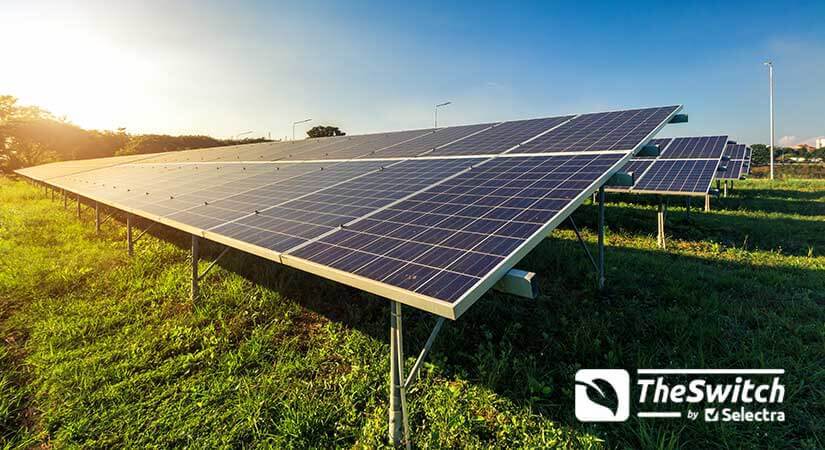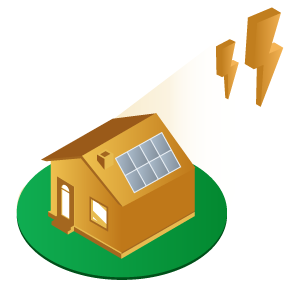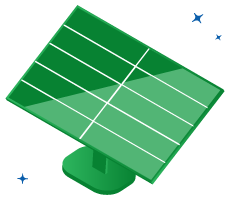Solar Energy in the UK: The Complete Guide

The UK is not known for its warm and sunny climate, so it may not seem an obvious country in which to generate solar energy. However, solar power generation only requires some level of daylight to extract the sun’s energy, meaning Britain can still harness solar power during our frequent overcast and rainy days.
The most recent data says that solar accounts for around 4% of Britain’s total electricity generation, up from 3.1% in 2016. Solar power is the third most generated renewable energy in the UK, after wind energy and biomass. The UK is the third largest producer of solar energy in the EU, behind Germany and Italy.
What is solar energy and how is it used?
Solar energy is energy sourced from the sun. The sun radiates incredible amounts of energy and, in a single hour, produces enough to meet the world’s electricity needs for a whole year. Thanks to advances in technology, we can capture this abundant source of energy and use it to power our homes, businesses, vehicles and more.
However, capturing solar energy is still somewhat expensive and inefficient, which is why we're not fully powered by solar energy just yet. Thankfully, this is slowly changing, as improvements to the technology are increasingly making solar energy infrastructure cheaper and more efficient.
There are two forms of energy that can be generated from the sun for our consumption - electricity and heat. Both of these are generated through the use of solar panels, which can either be mounted on roofs of buildings or at ground level in vast solar parks - also known as solar farms. We're now going to take you through each of these individually:
Solar PV Panels

Energy in the form of electricity is generated from the sun by capturing the photons in the sun’s light using ‘photovoltaic (PV)’ solar panels. These panels contain ‘photovoltaic cells’ that collect the sun’s energy which an inverter then converts into electricity we can use. This form of renewable energy is often referred to as ‘solar PV.’ Any unused electricity generated is fed into the national grid to provide to other consumers around the country.
Solar PV panels are typically placed on a south-facing roof of a home or building in order to maximise exposure to the sun. However, they will still function at a reduced rate without pointing directly at the sun, so long as some daylight can reach the panels.
The UK has a combined capacity of 13.26 GW of solar PV power - enough to power around 3 million British households. According to the The Solar Trade Association, around 900,000 British homes have solar PV panels installed.
The rate at which they generate electricity varies depending on the amount of direct sunlight reaching the panels and the quality, size, number and location of panels in use. Solar panels on properties in the south of the UK are usually able to generate more energy than those in the north due to increased amounts of sunlight.
Solar Thermal Panels
Energy in the form of heat can also be captured and used for heating in the home. This is known as solar thermal or solar water heating and uses panels that are also mounted on a roof facing the sun. Solar thermal panels, however, work by heating water stored in a hot water cylinder to provide hot water and heating in your home.
Solar Farms in the UK

Solar farms, also known as solar parks or solar fields, are large areas of land containing interconnected solar panels positioned together to harvest large amounts of solar energy at the same time. They vary in size - often between one and 100 acres, and are located in agricultural or rural areas. Solar farms are designed for extensive solar energy generation that feed directly into the national grid, as opposed to individual solar panels which usually power a single home or building.
As of 2015, there were 426 solar farms located in the UK. The largest is currently Shotwick Solar Park in Flintshire, North Wales. Shotwick Solar Park is a 250 acre site with a total capacity of 72.2 megawatts and each year contributes to reducing CO2 emissions by over 202,000 tonnes, powering over 11,000 homes.
| % of UK’s renewables | UK homes with solar panels | Solar capacity annual growth |
|---|---|---|
| 27.1% | 1 million | 17% |
| % of British public support | Average solar panel cost | UK Solar farm 2020 target |
| 74% in favour | £5,500 | 2,000 sites |
What are 5 advantages of solar energy?
Solar energy has many advantages as a source of renewable energy. Here are five reasons to love solar power:
1. Eco-friendly & sustainable

Like other renewable energies, solar power is entirely clean as it doesn’t release any harmful emissions or pollutants. In fact, solar power does the opposite and contributes massively to reducing CO2 emissions produced by fossil-fuel powered energies.
The Energy Saving Trust estimates the average UK home with a solar PV system installed could reduce carbon emissions by 1.2 to 1.7 tonnes per year. Multiply that by the current estimate of over a million homes utilising solar PV panels and the numerous solar parks in operation across the UK, and that’s a significant reduction in the UK’s carbon footprint.
Unlike fossil fuels, solar power is also completely sustainable and abundant enough to last us for as long as the sun exists. According to scientists, the sun will continue shining for approximately 5 billion years, meaning we won’t run out of solar energy for as long as we occupy planet earth.
2. Reduces energy bills & pays for itself
Once solar panels are installed, homeowners can begin generating their own electricity for free. By signing up to the government’s feed-in tariff scheme, your energy supplier will actually pay you for each unit of electricity you generate, whether you use it to power your home or not.
Alongside this, depending on how much solar energy is being generated, it is possible to sell or export unused electricity back to the National Grid. This will vary and depend on factors such as the time of year, the hours of sunlight during the day, and your electricity usage. At certain times of the year, it is highly likely that excess electricity will be produced and can be sold back to the grid.
Thanks to the FIT scheme, generating your own electricity helps offset some of the solar panel installation costs and contributes to reducing your electricity bills. Over a period of 15 to 25 years solar panels are expected to have paid for themselves and will begin to make a small profit.
3. Accessible for ‘off the grid’ consumers
Solar power is ideal for those living in remote areas where access to the national grid is difficult or not possible. Solar panels can be used to generate electricity in any location that has access to sunlight, making it a very flexible and accessible method of energy generation.
This is particularly useful for caravan or motorhome owners or those living in extremely remote areas for example.
4. Reduces reliance on imports & creates jobs
Solar power generated in the UK reduces the need to import electricity from abroad. This not only creates energy industry jobs in the UK, but makes our energy supply and prices more secure, since foreign energy can vary in price as supply and demand changes.
Solar power jobs are another benefit of solar generation. The solar industry currently provides around 16,000 jobs in the UK and the renewables sector as a whole is expected to create up to 500,000 jobs.
5. Maintenance is minimal
Apart from cleaning the panels a couple of times per year and occasionally replacing parts such as the cables or inverter, solar panels are very easy to maintain and require little ongoing maintenance. As they do not use any moving parts, the general wear and tear of solar panels is minimal and mostly caused by the weather. They also tend to last 25 to 30 years before they must be replaced, although many solar panel suppliers will provide annual service checks for peace of mind.
Three disadvantages of solar power
While solar power has many advantages, there are of course a few disadvantages of solar power generation. Among them are:
1. Expensive to install
Even though solar panel costs have dropped 70% since 2010, installing solar panels is still a sizeable investment. To install panels on your home’s roof will still set you back thousands of pounds for the panels, equipment and installation costs. The major solar parks across Britain also require huge investments to plan and construct. The Cleve Hill Solar Park currently proposed for construction in Kent is set to cost around £400 million which will take quite some time for the developers to recoup.
2. Solar Power Generation is Unreliable and Inefficient
Since we are not blessed with a particularly sunny climate in the UK, solar panels are somewhat restricted to the amount of power they can generate. Although solar panels can still function on overcast and rainy days, their efficiency drops greatly during these times. Once the sun has set, they also cease to function and since electricity is expensive and difficult to store, backup sources of electricity are needed during the night.
Generation also varies quite significantly throughout the year. For example, between April and June 2017, the UK generated 6% of the country’s total electricity from solar. Between October and December, however, it was just 1.5%.
Of course, generation during the summer months is far higher than during the winter months, creating a inconsistent source of energy throughout the year.
3. Solar Energy Storage is Difficult and Expensive
Since we cannot generate solar energy during the night, it makes sense to store up excess energy generated during the day to use when the sun sets. Unfortunately at the current time, solar batteries are still developing and are expensive and inefficient. This means it often makes more sense to buy energy from the national grid, or simply minimise electricity usage at night.
The Future of Solar Power in the UK

Plans for the largest solar farm in the UK are currently underway with the Cleve Hill Solar Park project in Kent currently being proposed for completion in 2020. If successful, it would be five times larger than Britain’s current biggest, Shotwick Solar Park in North Wales and increase Britain’s solar capacity significantly.
Developers of the Cleve Hill Solar Park aim to be able to generate up to 350 megawatts of electricity that could power 110,000 homes and save 150,000 tonnes of CO2. It is also set to go ahead without any government subsidies and will be financed entirely by private companies.
There are concerns however that its sheer scale could also be damaging to local landscape, wildlife and increase traffic and pollution to the area. Whilst they are currently still in the planning stage (as of May 2018), it remains to be seen if these environmental concerns will halt or delay the project from going ahead.
Government support for renewables waning
Even though projects such as Cleve Hill are positive steps forward, government support for solar power has waned since 2016 when their support for renewable energy took a step backwards. To the frustration of many, the government announced that there will be no further subsidies for renewable energy projects in the UK - at least until 2025. This is in an effort to reduce spiralling subsidy costs and is likely to have a major impact on the number and scale of solar projects in the coming years. It is also likely to slow down the recent growth the solar power industry has seen in recent years in Britain.
Disappointingly, the government has also decided to end the popular Feed-in Tariff scheme in April 2019. Again this shows the government’s support for the solar energy industry in the UK is in decline and makes the future of Britain’s solar power capabilities uncertain.
Greenpeace UK have also backed-up the notion that the British government is holding back our solar energy industry through unnecessary tax hikes and reductions in subsidies for major solar projects. They have also called for the government to continue to support and fund the solar power sector to create jobs, reduce carbon emissions and increase our access to and use of green energy.
The UK is missing its moment in the sun. Globally there has been record installation of solar panels. Solar technology is improving, costs are falling and forward-thinking nations are harnessing the power of the sun for clean, green energy. But UK ministers are stifling this cutting-edge industry instead of seizing the opportunity for jobs, investment and cheap energy. - Nina Schrank, energy campaigner
Subsidy-free solar projects
Britain may currently be ranked sixth in the world for solar power generation, but the government’s tax hikes and funding cuts to major projects will certainly slow down our recent growth. Despite this, subsidy-free, independent solar projects continue to launch and be planned for the future across the country.
There are a growing number of independent solar projects including the aforementioned Cleve Hill Solar Park who are pushing ahead without any subsidies from the government. The project is set to cost around £400 million which will be funded by two private companies.
All in all, it’s hard to predict the future of solar power in the UK. Although we have made great strides in solar technology, reduced infrastructure costs and increased usage across the country, the government seems set on slowing down this growth in any way it can. The only way forward at this stage appears to be through independently financed, subsidy-free solar projects. This, in combination with the continued uptake of small scale solar panel installations on British homes, should help ensure the industry continues to grow.
